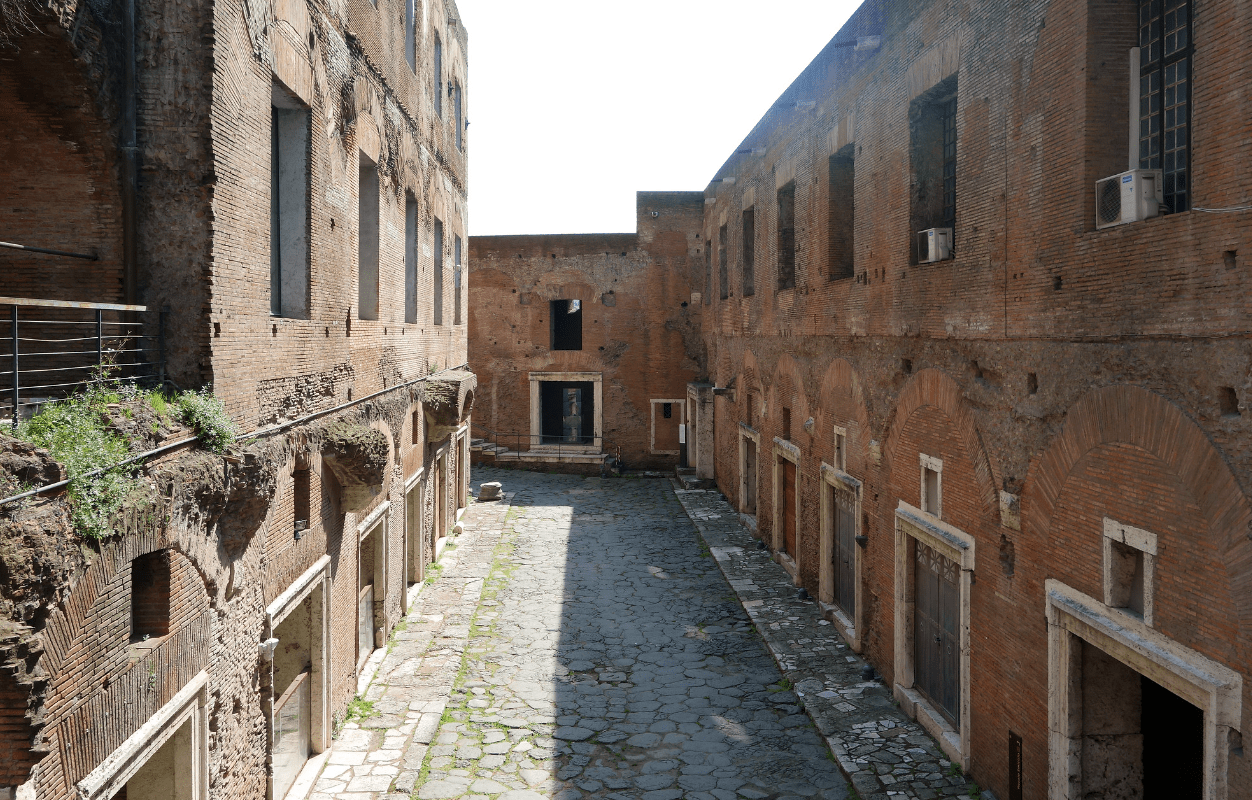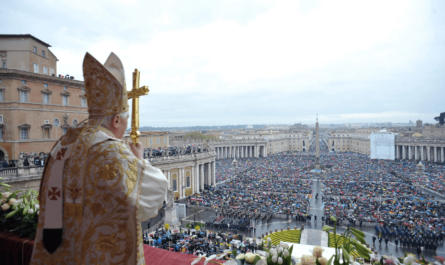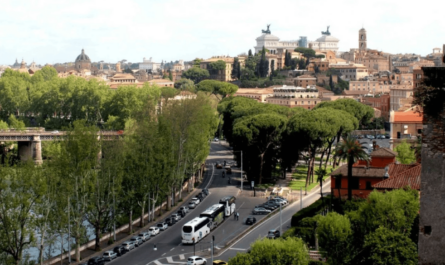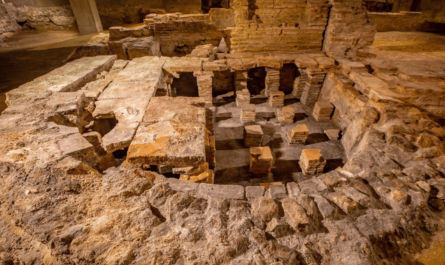Opened in 2007, Trajan’s Markets remains one of Rome’s lesser-known attractions, despite its prime location near Piazza Venezia and adjacent to the well-known Trajan’s Column. Unlike the bustling Colosseum, this site receives a fraction of the daily visitors. Its somewhat obscure entrance, situated behind Piazza Venezia, may make it less noticeable on the typical tourist path, but it’s certainly worth seeking out.
The Trajan’s Markets were constructed at the dawn of the 2nd century AD to conceal and stabilize the excavation done on the Quirinale hill for Trajan’s Forum. Although it’s commonly referred to as Trajan’s “markets,” the site wasn’t actually a commercial hub. Contrary to initial beliefs, it wasn’t used for trading goods, fruits, vegetables, or livestock. Instead, it served as the administrative center for the nearby Forum of Emperor Trajan.
If you’re limited to just one day in Rome, you might skip this site, but if you can extend your visit to three days or even a week, it’s definitely worth including. During our visit, which we anticipated would last an hour, we ended up spending over two hours exploring the markets and museum. The experience was so engaging that we lost track of time and nearly missed lunch.
We’ve put together a detailed guide for visiting Trajan’s Markets in Rome, including tips to enhance your visit.
The History of Trajan’s Markets in Ancient Rome
As suggested by its name, Trajan’s Markets is a significant archaeological site located in central Rome. Rediscovered in the early 20th century and fully renovated between 2005 and 2007, this complex served multiple functions for the adjacent Trajan’s Forum. It was primarily an administrative hub for managing the forum where the emperor conducted public functions and official ceremonies.
Historians have deduced its administrative role from the layout of its spaces, which are connected by staircases and streets not accessible to carts, indicating office use closely linked to Trajan’s Forum, including the office of the procurator, who oversaw the administration of the complex and the forum.
Some areas were used by imperial treasurers, and others served as venues for official ceremonies and public events. After the fall of the Roman Empire, the Trajan’s Markets continued to be used. During the Middle Ages, it was converted into a fortress by local nobility, with added defensive towers.
Over time, the complex fell into disrepair in the 15th and 16th centuries, and in the late 16th century, it was adapted for use as the convent of Santa Caterina da Siena. Following the Italian unification, it was occupied by military barracks until the early 20th century when restoration efforts began.
The Architecture of Trajan’s Markets in Rome
The lower section of the complex features the “Grande Emiciclo” (Great Hemicycle) and “Piccolo Emiciclo” (Small Hemicycle). The Great Hemicycle, with its three levels, includes two large semicircular halls covered by a semi-dome.
In Roman times, the southern hall likely had a façade with large windows and a round arch. It served not only as support for the Quirinale hill’s excavation but possibly also as an auditorium for public lectures, music events, or educational activities.
The Small Hemicycle, also built on three levels, has a semicircular layout and a distinctive black mosaic floor. The upper floor mirrors the lower level’s semicircular design and features large windows, with a corridor leading to a staircase and additional rooms opening onto Via Biberatica.
An ancient Roman road, Via Biberatica, connects the lower and upper sections, crossing modern Via Quattro Novembre and extending towards Salita del Grillo.
Behind the central structure of the Trajan’s Markets lies Via della Torre and the Giardino delle Milizie (Militia’s Garden), named after the 13th-century Torre delle Milizie, which gave the complex its military appearance.
From the windows of the halls, you can view the imperial fora. In ancient times, other connected spaces and rooms were located across Via Biberatica.
The Trajan’s Markets were built using the Roman construction method known as opus lateritium, involving coarse brickwork over a core of opus caementicium, or Roman concrete.
Image: Building material and architecture of the Trajan’s Markets in Rome
Key Attractions in Trajan’s Markets
The Trajan’s Markets consist of several buildings arranged in six tiers on the Quirinale hill. After exploring the Great Hemicycle, you can descend into the Trajan’s Forum, a significant archaeological site visible from Piazza Venezia.
The markets offer a fascinating glimpse into ancient Rome, with relics from the forum and an impressive collection of artifacts. Some parts of the Small Hemicycle were modified in the 17th century when the Ceva-Tiberi palace was constructed.
Due to later developments in the surrounding area, some sections of the markets, including walls and entrances from Via Biberatica, were removed. Moving from the Great Hemicycle to the Forum reveals remnants of carved pillars and walls.
Image: Great Hemicycle in Trajan’s Markets Rome archaeological site
Museo dei Fori Imperiali
Trajan’s Markets is more than just an archaeological site; it houses the Museo dei Fori Imperiali, one of Rome’s premier museums. Your visit begins on the ground floor with the Great Hall, likely used for official ceremonies and an introduction to the markets and the Imperial Fora.
The museum’s rooms are dedicated to each imperial forum, culminating in a section on Trajan’s Forum and a 17th-century cistern displaying amphorae.
Explore the exhibits of Caesar’s Forum (46 BC), Augustus’ Forum (2 BC), Templum Pacis (75 AD), Nerva’s Forum (97 AD), and Trajan’s Forum (112-113 AD). These forums, constructed over 150 years, were central to administrative, judicial, and ceremonial activities.
The museum’s upper floor features intriguing collections from Caesar and Augustus’ Fora, showcasing relics from two of Rome’s most influential figures. The Museo dei Fori Imperiali offers a wealth of artifacts, sculptures, and pieces from the monumental columns and statues of each forum, enhanced by descriptive panels, videos, multimedia installations, and three-dimensional reconstructions.
Practical Information for Visiting Trajan’s Markets
Address: Via Quattro Novembre 94
How to get there: Accessible via public transport, with buses like 64 or 40 Express from Stazione Termini, or buses stopping at Piazza Venezia such as 51, 60, 63, 81, 64, 628, or tram 8.
Opening hours: Daily from 9:30 am to 7:30 pm, with the last entry one hour before closing.
Entrance fee: €13.
Website: Trajan’s Markets
Tips for an Enhanced Experience
- Wear comfortable footwear: Expect staircases, extensive walking, and standing, so choose shoes suited for long periods of exploration.
- Bring a hat: The site includes both covered and open areas, so a hat will shield you from the sun.
- Apply sunscreen: Essential during summer visits to protect your skin.
- Allow ample time: We intended to stay an hour but ended up spending nearly three hours due to the site’s fascinating details.
- Carry water: While there may be vending machines, it’s wise to bring your own bottle to avoid wasting time searching for refreshments.
Nearby Attractions
Located in central Rome, Trajan’s Markets is just minutes from Piazza Venezia, Via del Corso, and the Trevi Fountain, placing you near many of Rome’s major landmarks and the intriguing archaeological site of Vicus Caprarius.
The location is ideal for combining sightseeing with shopping. If you have at least two days in Rome, consider visiting Palazzo Venezia in Piazza Venezia for insights into local notable families. Explore Via del Corso, Galleria Alberto Sordi, the Pantheon, Piazza Navona, Spanish Steps, and Piazza del Popolo.
If you’ve explored Tridente and Centro Storico, head uphill from Trajan’s Markets to the Monti neighborhood, known for its hidden gems, including Basilica of San Pietro in Vincoli, a vintage market, and the quintessential Roman square lifestyle.
Dining Options Near Trajan’s Markets
While immediate dining options around the museum aren’t remarkable, a short walk leads you to restaurants near the Trevi Fountain, such as Baccano, known for its good food and ambiance, albeit at a higher price. For a more affordable option, Aromi Bistrot on Via Quattro Novembre 137/M-138 is a casual choice.
For a healthier, casual meal, visit Ginger Sapori on Via Borgognona. If time allows, consider Armando al Pantheon, a top spot for traditional Roman cuisine.
In summer, treat yourself to gelato at San Crispino gelateria, located less than ten minutes from the Trevi Fountain.



